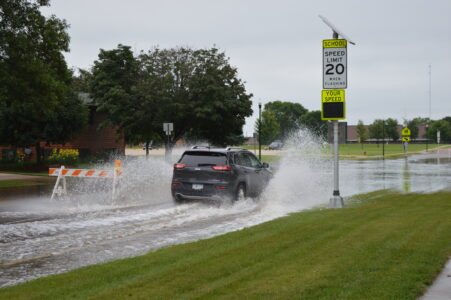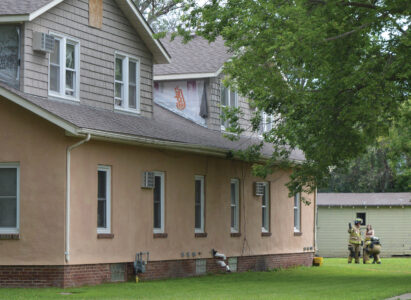The ‘FAQ’ on the new state flag
Gaul gives talk on Minnesota flag redesign process

Minnesota’s new state flag was a controversial topic for some members of the audience at a talk in Marshall Tuesday night. Dan Markell spoke out in favor of keeping the current state flag.
MARSHALL — The new designs of Minnesota’s state seal and flag drew mixed reactions from a crowd of Marshall area residents on Tuesday evening. But the process of choosing new designs to represent Minnesota was one that considered many viewpoints, including thousands of public comments, Anita Gaul said.
“We solicited public feedback at every step of the way. And Minnesotans responded,” Gaul said.
Gaul, a Marshall resident who served as vice-president of the State Emblems Redesign Commission (SERC), gave an informational talk on the new state flag Tuesday at the Marshall-Lyon County Library. The event drew a crowd of about 60 people.
“I know there was a lot of interest in this topic, so I anticipated that attendance would be high. I just didn’t realize how high,” Gaul said.
Gaul said she wanted to answer frequently-asked questions about the new state flag and seal, including why and how the redesigns were done.
There was a short answer and a long answer as to why Minnesota designed a new state flag and seal, Gaul said. “The short answer is, it’s the law,” she said. In the 2023 state Legislative session, a bill was passed creating SERC and tasking it with adopting a new state flag and seal by Jan. 1, 2024.
The long answer as to why the flag and seal were changed had to do with design and history.
“I will quote from one of the co-sponsors of the bill, Rep. Mike Freiberg: ‘The current flag is a cluttered, genocidal mess.’ So, let’s break down that quote a little bit,” Gaul said.
The current Minnesota flag design – the state seal on a blue background – goes against several principles of good flag design, Gaul said. There’s “a lot going on” on the seal design, including several state symbols, a number of dates, and lettering. The current flag design also doesn’t stand out amongst many other U.S. state flags.
“About 20 states have this basic design – the seal slapped on a blue bed sheet design – so we are not distinctive in any way,” she said.
The other half of Freiberg’s comment had to do with how the state seal and flag represents Native Americans, Gaul said. The current seal and flag show a Native American riding westward away from a white settler.
“I know the word ‘genocide’ is a contentious word,” Gaul said. “A lot of voices out there right now say that the seal is absolutely not genocidal, it honors America’s or Minnesota’s Indigenous citizens.” However, Gaul encouraged the audience to consider historical evidence of what the seal and flag represented.
She shared an 1850 poem written by Mary Eastman, an author and wife of Seth Eastman, the state seal’s co-designer. Eastman’s poem, “The Seal of Minnesota,” said Native Americans must “give way” to white people, and included lines like “We claim his noble heritage/And Minnesota’s land/Must pass with all its untold wealth/To the white man’s grasping hand.”
Gaul said Minnesota Gov. Henry Sibley also altered the seal design to reflect the idea of Manifest Destiny.
“When the Minnesota Legislature approved this seal in 1858, they approved a design where the American Indian was riding eastward toward the white settler to portray harmony,” Gaul said. “Governor Sibley, unilaterally and without legislative approval, switched it to show the Native American riding away towards the west to show the settler driving him away. . . That is why, to many Minnesotans, this seal is offensive.”
Efforts to change the Minnesota state flag and seal got started in the late 1960s and picked up steam in the 1980s, Gaul said. Bills to change the state flag have been introduced repeatedly since 2000 by members of both the Republican and DFL parties.
Gaul also went over the process that SERC used to choose new flag and seal designs. The commission was made up of people representing a variety of Minnesota communities and design backgrounds, as well as three members of the public and four non-voting state legislators.
“There were five of us from greater Minnesota. Three of us had voting privileges,” she said. Gaul said she was accepted onto the commission after taking part in an open application process for the general public.
“I viewed my role was to represent rural Minnesota, and in particular southwest Minnesota and the agricultural community,” Gaul said.
The commission asked for the public to submit designs for the new flag and seal, and they received over 2,500 responses. “Every single person in this room could have just submitted up to three designs for flag and seal – it was open to everyone,” she said. “Each commissioner spent hours and hours and hours going through all of those designs.”
In addition, SERC also took public comments through the redesign website. As the commission narrowed down options for the flag – first down to 400, then to a couple dozen, and to six finalists – they kept taking public comments. Gaul said.
“Nearly a quarter of a million people checked out the website to look at the designs,” she said. A total of 21,882 public comments on the redesign finalists were collected by the SERC web page, and individual commission members received hundreds of additional comments via e-mail and in person, she said.
The whole process was also under “intense” media scrutiny, Gaul said. “This was aired on the radio, online, in newspapers, everywhere.”
The final flag design chosen by the commission was created by Andrew Prekker, of Luverne. The new flag includes the symbol of the north star, a stylized outline of Minnesota, and a light blue background representing the waters of the “Land of 10,000 Lakes.”
The new flag and seal are set to take effect on May 11, Minnesota’s statehood day. “The legislature is not required to take any further action, nor is there any vote necessary,” Gaul said. Minnesota is not a referendum state, and constitutional amendments are the only changes that get put to a statewide public vote.
Agencies that have materials like letterhead with the old flag or seal on them will be able to use their current stock until it runs out, or until January 2025, Gaul said. “There is no mandate that says this stuff has to be replaced overnight.”
Not all audience members said they liked the new design.
“I’m not against changing the flag, I’m against what they chose for the flag,” one audience member said. He thought it would have worked well to put the new state seal on the flag instead.
Other speakers questioned why the new seal did not include elements like the year that Minnesota became a state, or why the design wasn’t put to the people of Minnesota for a vote. At the same time, one audience member said, “You guys put in a lot of work and you’re to be commended.”
Audience member Dan Markell held up a current Minnesota state flag, saying, “This flag is what’s going stay on my flagpole, forever.”
“As we’re reminded every November, if you don’t participate in democracy, don’t be complaining about it. This was a democratic process. It was advertised, you had an option to sit on the commission, you had an opportunity to give a comment,” said audience member Jim Smalley.
Gaul said she had received several requests to talk about the flag redesign in southwest Minnesota communities. The event in Marshall was the first of six she was invited to. Some of her upcoming area talks will be at noon Thursday at the Murray County 4-H building in Slayton, and at the Adult Community Center in Marshall on April 9.



